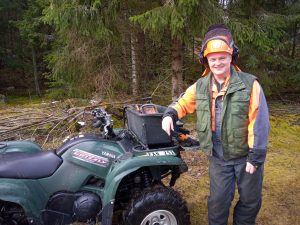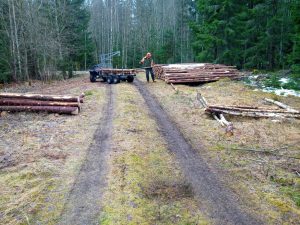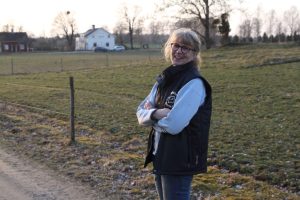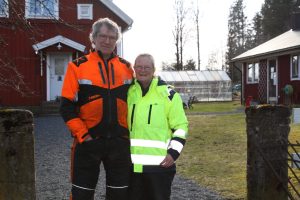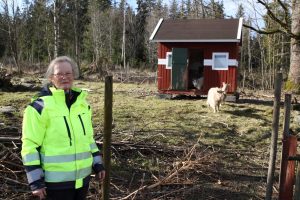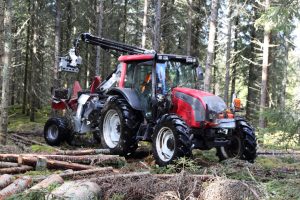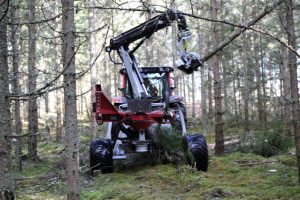The forest area of Sweden is 23,5 million hectares or 58 % of the total land area, as we wrote in the first article in this series, Swedish Forestry #1. But who owns it? Well, let´s try to sort that out.
The owners in figures
In 2017 there were 319 649 forest owners (persons) of which 38 % were female, 60 % were male and 2 % were of unknown gender. 7 290 of those forest owners were non-Swedish. The number of units was 224 888 the same year. Of those 67 % were owned by persons who lived on their estate, 26 % lived somewhere else and 7 % lived on one estate, and in the meantime owned other estates.
The distribution of the forest land in 2017 was as follows:
- 48 % individual owners
- 24 % private owned limited liability companies
- 13 % state-owned limited liability companies
- 6 % other private owners
- 7 % state owned forest
- 2 % other public owners (churches etc.)
Forest owners’ associations
There are three forest owners´ associations in Sweden today (until recently there were four, but the two northern ones incorporated and became Norra Skog “North Forest” in March 2020).
It all started in 1906, in Dalarna, in the middle of Sweden. “The idea is to be stronger together without personal responsibility.” The small forest owners had suffered under long term contracts that had been dictated by the forest industries. According to the contracts, the forest owner had no, or very few, rights to their forest land during the 50 years of the contract that was common. In the contracts, there were as good as never any obligations to reforest the land after the forest had been cut.
The purpose of the associations was to make sure that forest owner´s rights were taken into consideration and to make sure that the members got the right value for their forests, meaning that the forest land should be profitable for its owners. Together, the possibility to affect the prices for wood was better than it was for single forest owners.
A large number of small forest owners´ associations were founded all over Sweden during the upcoming decades after 1906. Today there are three major associations:
Södra 52 000 members (in the south of Sweden)
Mellanskog 26 000 members (in the south and mid-Sweden)
Norra Skog 28 000 members, (in the north. Until recently this was two associations; Norra Skogsägarna and Norrskog))
Who buys the wood?
In total there are quite a few wood buyers in Sweden. Small private-owned sawmills, large industry groups and the forest owner associations who have their own industries. As a matter of fact, in south Sweden Södra is the largest forest industry group with a number of both saw- and pulp mills.
Stora Enso, Holmen, SCA, Sveaskog, Billerud Korsnäs, Derome and Vida are some of the larger forest industries apart from the forest owners’ associations and all the private sawmills. This diversity of buyers, especially in south Sweden, makes the wood market the sellers, the forest owners, market which also shines thru on both woodland- and wood prices. Forest land is, however, seen as a very good investment, despite the high purchase prices.
The typical forest owner
I´m not sure if there is a “typical forest owner”. A forest owner in Sweden today could be anyone: A farmer, an investor, a lawyer, an accountant, a banker, a hunter or a factory worker. It could be someone who inherited some forest land, someone who bought it because they like the countryside, someone who likes horses, someone who wants to live in the forest or someone that lives in a city. There are lots of reasons to own a forest. Here below we will present three forest owners with slightly different goals with their ownerships.
Mikael
Mikael runs his own business as an IT consultant helping different companies and organizations to sort out their business systems. He has had quite a success in the last some 15 years and have frequently bought forest land for the money he has made as an IT consultant and by stock trading. Later on, he has also financed the buying by cutting some of the forests he has bought.
He started off by studying forestry, and graduated as a forester, but later changed track into IT. His passion for the forest has however always been there. Today he owns over 300 hectares of forest land together with his wife and they are constantly searching for more suitable land to buy.
Although living in the city, Mikael spends as much time as possible in the forest. He wants to manage it himself, but he hires loggers to do most of the practical work. For the moment he is forwarding some wood from a first thinning made by one such logger, with his ATV.
His long-term goal with his forest ownership is to be able to make a living on what comes out from the forest. He is very interested in forest management and forest production, he likes to try out, and use, the best methods to receive a sustainable forest that gives the most possible payback by the time for clear-cut.
Apart from the pure business aspect of forest ownership, he and his family are keen on outdoor life such as fishing, hunting, berry- and mushroom picking.
Carina
Carina has an 80 % part-time job as managing director for the Swedish Beef Producers Association. She is also a beef producer herself with 11 cattle on the farm where she lives and has her job office. She manages her livestock on the 20 % of the time that she is not doing her ordinary job.
Her farm contains 22 hectares of field land and 30 hectares of forest land. She is a member of Södra, from who she buys forest managing services. Södra also buys the wood that is cut on the estate. Carina does not work in the forest herself but has a precise idea want she wants with the forest: She wants a mixed forest of pine, spruce, birch and, when possible, other hardwood species. Her forest should be as productive and ecological as possible.
Like many other forest owners, she has a forest management plan (made by Södra) where she can see the content and what there is to be done in each stand and at what time the actions should be taken. The time frame in such a plan is normally 10 years.
Her long-term goal is to create a valuable forest, both economically and environmentally.
Ronny and Marie
Ronny was born and raised on his estate. At a very young age he had to learn everything about running a farm. Milking the cows, doing the fields and working in the forest. In 1975, at the age of 18, he took over the farm from his parents and has been running it ever since.
Today he is married to Marie who is also heavily involved in the farm. They have 107 hectares of forest land and 11 hectares of field. They also lease field areas, so in total their farming land is about 50 hectares.
Diverse farming
The milk production at the farm was closed down many years ago, but they do have a livestock of 40 cattle for meat production. Also, something that could be described as a children’s zoo, for which Marie is responsible, is to see at the farm. Goats, pheasants, doves, geese, rabbits, chickens and more from various breeds are there to attract visitors from more or less everywhere.
Marie also has a garden where she grows vegetables and flowers, outdoors and in a greenhouse. In the summertime, this farm is a tourist attraction where families go to let the children see animals in real life and to buy flowers and ecological vegetables.
Ronny focuses on the cattle, the fields and the forest. He does everything in their own forest, planting, pre-commercial thinning, thinning and clear-cutting. He also manages two neighboring forest lands.
For the forest work, he has a Hypro harvester and a forest trailer with grapple loader. Both machines are attached to his Valtra tractor.
The annual cut is approximately 80 % of the growth, 400 – 500 cubic meters both in thinning and clear cuts.
Marie and Ronny are good examples of farmers who use their creativity to make a living from the land they have by thinking outside the box. It´s obvious that they also have managed to create a good life for themselves.
The long-term goal is to leave the forest as valuable and well managed as possible, to whoever the future owners turn out to be.
Sources: Swedish Forest Agency (Skogsstyrelsen) “Rapport 2018/12”, sodra.com, norrskog.se, mellanskog.se and interviews with the three forest owners.






